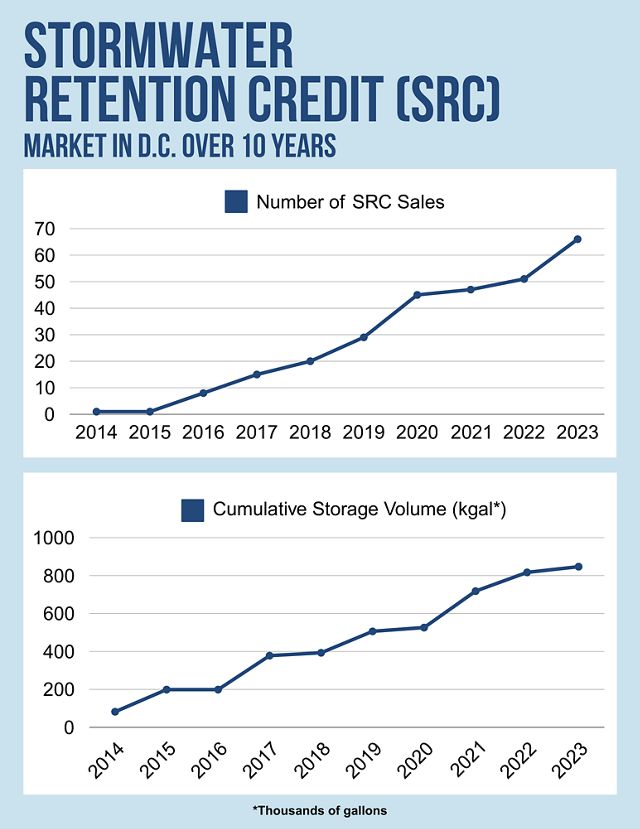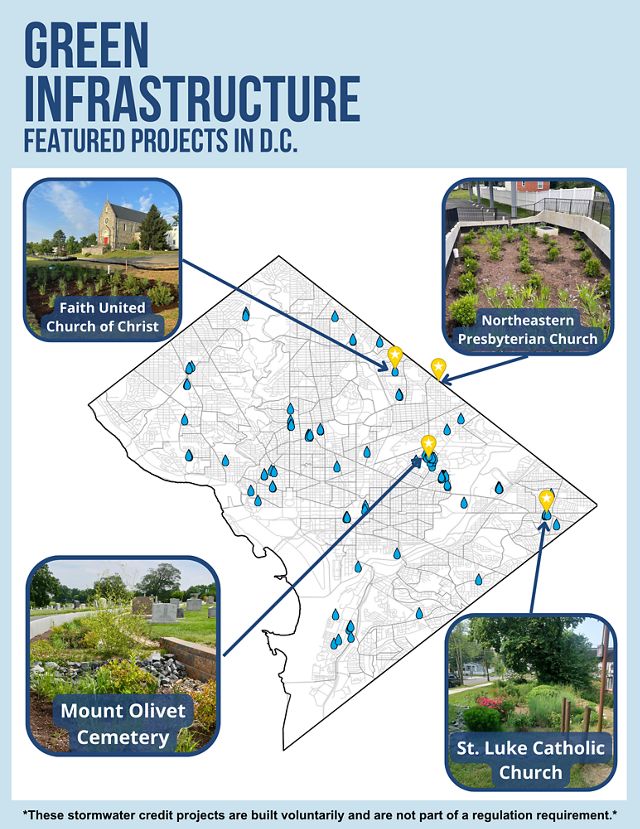Ten Years in, D.C.’s Stormwater Credit Market is Thriving and Still Growing
The District’s innovative approach to stormwater management has become a globally examined model.
Media Contacts
-
Matt Kane
Phone: 323-898-6510
Email: matthew.kane@tnc.org
Ten years ago, Washington D.C. established the Stormwater Retention Credit (SRC) market, a first-of-its-kind program that allows developers to meet a portion of their stormwater retention requirements by purchasing credits generated from green infrastructure projects built elsewhere in D.C. This innovative market model has distributed green infrastructure throughout the District, increasing the amount of stormwater-capturing green space in historically under-resourced areas and improving local water-quality. Since the first credit sale in 2014, the market has grown each year, playing a key role in the District’s overall stormwater management strategy. To date, more than 1.7 million credits have been sold, representing over 40 million gallons of runoff captured and cleaned annually.
“The SRC Trading Program incentivizes investment in green infrastructure in areas where untreated stormwater drains directly into our waterbodies, increasing overall retention across the District,” said Department of Energy and Environment (DOEE) Director Richard Jackson. “Entering its second decade, the Bowser Administration and DOEE remain committed to expanding this innovative program to catalyze green infrastructure development where it is most needed, support the growing SRC Aggregator community, and provide developers with flexible options to meet their regulatory obligations."

Up to three billion gallons of polluted stormwater run-off and sewage flow into D.C.’s local rivers each year, which eventually reach the Chesapeake Bay. To address this and meet its Clean Water Act obligations, the District requires major, new construction and renovation projects within D.C. to capture stormwater runoff from their property sites through green infrastructure. The SRC market is an innovative solution to easing the burden on developers by allowing them to meet a portion of their stormwater obligations by purchasing credits from the market, thereby incentivizing other landowners to install new projects of their own. This also allows the District to be more strategic about addressing both environmental and community needs, as these projects can also provide significant ecological and social co-benefits such as increased pollinator habitat and public green space. The District also offers grants and some technical assistance to help participants get started in the market, as well as a price guarantee for eligible credit sellers.
Since its inception, the D.C. SRC market has drawn interest from cities around the world seeking solutions to their own stormwater issues, with some developing their own markets inspired by Washington’s. Grand Rapids, Michigan and Cook County, Illinois have both developed stormwater markets to meet their regulatory requirements. The Grand Rapids Stormwater Credit Trading Program closely follows the DC model, while the Cook County market, StormStore, adjusted the model to meet their local needs. Case studies on the D.C. SRC market are also being taught at multiple universities—including Harvard and Columbia—and helping to inform the next generation of practitioners in the civil engineering and policy sphere. Washington D.C. is now a leader in this space.

The Nature Conservancy and the Catholic Archdiocese of Washington collaborated on the very first voluntary credit-generating project at Mount Olivet Cemetery, where raingardens were installed at various locations to capture runoff. The reinvestment of credit sales has helped the partners to further expand the project, with construction on the third and final phase having recently been completed. Reinvestments of credits also provides the opportunity to fund new projects. The Nature Conservancy is currently working with another cemetery landowner to install a new project in the coming year.
“The Nature Conservancy believes the SRC market is an innovative way to unlock private capital in the stormwater world, and for stormwater projects to be strategically built where there is the highest environmental and community benefits, instead of being constructed based solely on developments patterns” says The Nature Conservancy’s Maryland/DC State Director Kahlil Kettering. “The ability to accelerate the construction of green stormwater infrastructure to meet the challenges of the region is why TNC became involved in the market.”
There are currently 26 distinct sellers of credits on the market, which you can find more information about on the SRC registry.
Green Compass began investing in the SRC market in 2019, and the projects they have built have created 6,300 square feet of new urban green infrastructure and planted hundreds of new trees at no cost to site owners in Wards 5, 7 and 8. According to a valuation by Earth Economics, every dollar the company invested to build green infrastructure returns $7.80 in benefits to the local community every year.
“Generating environmental credits with green infrastructure is an opportunity to direct private investment into long term pollution reduction and flood mitigation with nature-based solutions,” said Green Compass CEO Nicole Whalen. “Over the next 10 years, we hope to see the SRC market grow with more demand from developers in DC choosing SRCs as a cheaper, easier, faster alternative to stormwater management, more site owners benefiting from hosting green infrastructure, positive price movement for high-impact SRCs, and more investors and municipalities participating in stormwater trading to reduce pollution and flood risk—especially within shared watersheds like the Chesapeake.”
As it continues to grow, D.C. is continuing to explore policy updates to the market from lessons learned from its first 10 years. The District is also exploring new ways of supporting small, local businesses getting into the credit market, as well as see more local landowners directly benefit from credit sales.
The Nature Conservancy is a global conservation organization dedicated to conserving the lands and waters on which all life depends. Guided by science, we create innovative, on-the-ground solutions to our world’s toughest challenges so that nature and people can thrive together. We are tackling climate change, conserving lands, waters and oceans at an unprecedented scale, providing food and water sustainably and helping make cities more sustainable. The Nature Conservancy is working to make a lasting difference around the world in 81 countries and territories (40 by direct conservation impact and 41 through partners) through a collaborative approach that engages local communities, governments, the private sector, and other partners. To learn more, visit nature.org or follow @nature_press on X.
